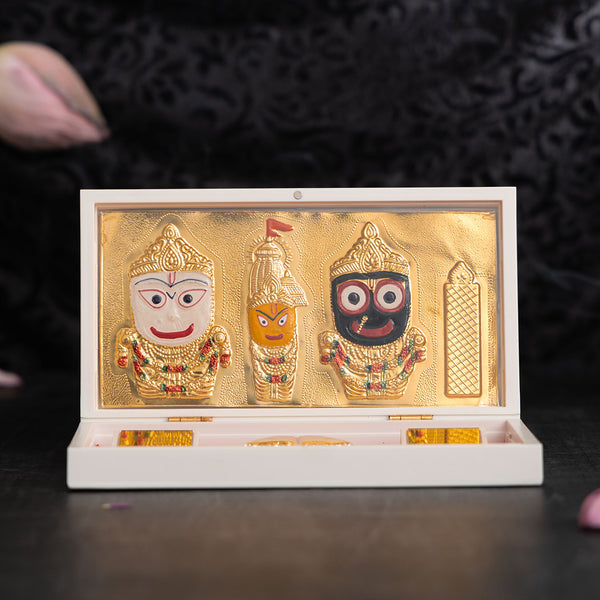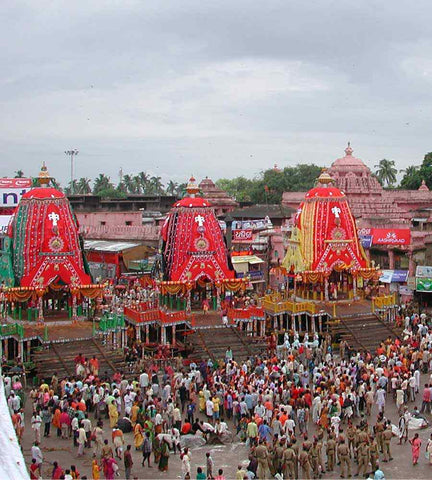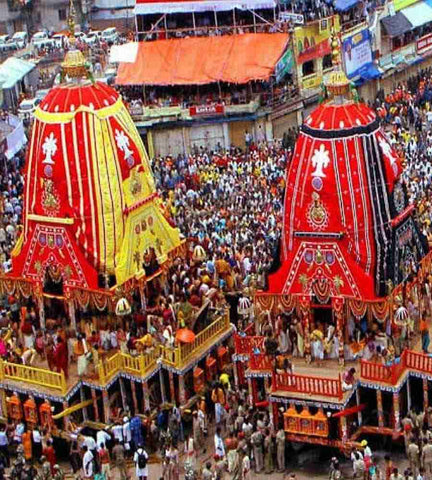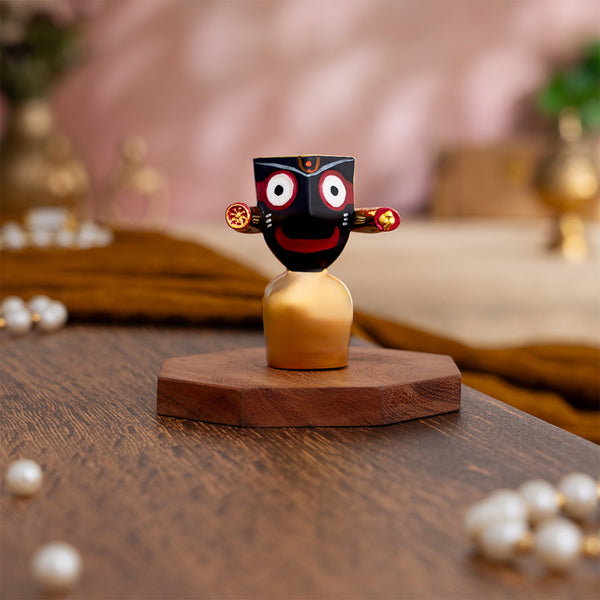There are few stories as popular as that of Lord Krishna and all his feats and antics. A deity worshiped and loved by all, this dark-skinned Lord has several legends to his name. And one such famous one is the story of Lord Jagannath Rath Yatra story.
Every year in Puri, Odisha, hundreds of thousands of devotees gather for the Lord Jagannath Rath Yatra, also known as the Chariot Festival.
Believed to be celebrated for Lord Jagannath, Lord Balabhadra, and their sister Subhadra are honored for making a pilgrimage from the Jagannath Temple to the Gundicha Temple.
The ceremony has been practiced for over a thousand years and has deep spiritual and cultural meaning for its participants.
Thousands of worshippers pull ornately painted chariots carrying the deities while singing hymns and songs of devotion. As a celebration of the unbreakable tie between Lord Jagannath and his followers, it brings people together and inspires devotion.

Svastika Jagannath Pocket Temple - Gold Coated

Lord Jagannath, Subhadra, Balabhadra Murti Set - Gold Plated (4 Inch)
What is the Story Behind Lord Jagananath Rath Yatra?

The story behind the Rath Yatra, or Chariot Festival, revolves around the belief that Lord Jagannath, an incarnation of Lord Vishnu, along with his siblings Lord Balabhadra and their sister Subhadra make their journey to the Gundicha Temple, their aunt's house during the Rath Yatra, also known as the Chariot Festival.
Lord Jagannath, like any other person, supposedly wants to spend time with his aunt every year when he returns to his place of birth.
Devotees eagerly aid in this by helping pull the chariot through Puri. It is thought that anyone who touches the chariot's ropes will receive a blessing and have their sins forgiven.
People from all walks of life gather to honour Lord Jagannath and share in the celebration of his heavenly voyage.
Rath Yatra Origin Story

1. Krishna Broke his Promise
Lord Krishna had to stay away from Vrindavan for a hundred years. Greatly saddened and devastated by this news, the Gopis refused to let lord Krishna leave, even though he promised to return after a brief period.
However the Gopis tried stopping the chariot by pulling it and refusing to let go of the reins of the chariot, proclaiming that they will not let them leave.
The Gopis were laying in the path of the chariot's wheels and beating up Akrura, shouting, "You want to take Krishna, we will never let you do that." As a result, the gopis were in a terrible bind.
Lord Krishna reassured them by telling them it was his responsibility and he could not refuse an invitation from the King, therefore, they need to let him go.
However, though Lord Krishna had a great many capabilities, he was notoriously known for not adhering to his words.
There is often no weight to his statements. Krishna knows that his words may fail, but the words of his followers will never fail, therefore if he wishes to make a promise or comfort someone completely, he does so via them.
2. Gopis and Krishna went to Kurukshetra
For a hundred years, Krishna remained away from Vrindavan.
However, on the auspicious occasion of a solar eclipse (Surya Grahan), it was customary for people seeking piety to go to Samanta Panchak in Kurukshetra to take a holy bath.
Many individuals, including the gopis (cowherd girls), went to Kurukshetra for the sacred bathing ritual.
Meanwhile, the residents of Vrindavan also embarked on the journey to participate in the holy bath. To their surprise and delight, they received news that Krishna and Balarama were present in Kurukshetra.
Upon hearing this, the residents of Vrindavan were filled with immense joy and rushed to meet Krishna and Balarama.
They eagerly anticipated reuniting with Krishna, after his long absence, and were overjoyed at the opportunity to be in his divine presence once again.
3. Radha was Unhappy
As the time for departure drew near, Krishna was already seated on his chariot. When the residents of Vrindavan arrived at the scene, their hearts overflowed with excitement and joy.
However, there was one person whose mood differed - Radha Rani. She couldn't find the same elation as others did, for she believed that the person on the chariot was not her beloved Nandalala, Krishna.
Radha refused to believe this was her Krishna. Her Krishna wore a humble peacock feather on his head, but the figure on the chariot wore a majestic crown. Her Krishna donned simple yellow garments, while the charioteer was adorned in regal attire fit for a king.
The garland that her graced Krishna's neck was woven from wild forest flowers, yet the person before her wore necklaces embellished with the most precious gems and jewels. Her Krishna carried a melodious flute, but the figure in front wielded a bow, arrows, and a sword.
Radha and Lord Krishna usually met in secluded spots along the banks of the Yamuna, but this was a crowded noisy place that contrasted with her memories of Lord Krishna.
The air resounded with the trumpeting of elephants, the whinnying of horses, and the clamor of countless people. This was not how Radharani had envisioned meeting her beloved Krishna.
4. Devotees Started to Pull Krishna's Chariot
Lord Krishna's devotees rushed to take control of his chariot, which was already fitted with harnessed horses. They began pushing the chariot together, with pure devotion and passion.
Not only Krishna's chariot but also his brother Balarama's chariot was being drawn forward. Subhadra, their adored sister, could not be left behind and joined them on this holy voyage. Vrindavan was their destination.
Thus, the Rath Yatra event represents Lord Krishna, Balarama, and Subhadra hauling their chariots from Kurukshetra to Vrindavan. It reflects the devotees' earnest desire to rejoin Krishna with his eternal love, Srimati Radharani.
The Gundicha Temple is a portrayal of Vrindavan, Lord Krishna's hallowed residence, in this story. The Rath Yatra event is transformed into a joyful occasion in which devotees pull the chariots, metaphorically bringing Krishna and his holy presence closer to Radharani in Vrindavan.
Meaning of Rath Yatra

In Hinduism, the Rath Yatra, or Chariot Festival, is highly significant and meaningful. The word "Rath" signifies chariot and the word "Yatra" means a trip or pilgrimage.
This magnificent celebration takes place in Puri, Odisha, India, and honors the legendary journey of the gods Jagannath, Balabhadra, and Subhadra from the Jagannath Temple to the Gundicha Temple.
There are several metaphorical underpinnings to the Rath Yatra.
In the first place, it symbolises the deities' trip from their holy abode to their aunt's house, which is symbolic of the universal yearning to spend time with one's family and feel their love.
It represents God’s innate desire to be in a relationship with everyone and everything.
The Rath Yatra also serves as a symbol of the togetherness and dedication of the worshippers. To pull the chariots is a metaphor for drawing the divine closer to oneself and forging a closer bond with the gods.
It's a symbol of giving up, of putting others before oneself, and of the hope that through working together, we can get closer to God.
The festival is also a timely reminder of the transience of all things and the value of letting go.
Each year, following the festival, the chariots are torn down, symbolising the fleeting nature of material goods while highlighting the eternal essence of the divine.
As a whole, the Rath Yatra is a festival that honours faith, fellowship, and the quest for enlightenment. It captures the heart of love, family, and the eternal search for oneness with the divine, leading believers on a spiritual quest.
Rath Yatra is Popularised Around the World
The Rath Yatra, also known as the Chariot Festival, has become increasingly well-known and celebrated over the years.
The spectacle of the celebration, with its huge chariots, colorful processions, and devoted participants, has drawn visitors from all over the world.
The message of devotion, unity, and spirituality conveyed by the Rath Yatra has expanded to audiences all over the world thanks to the Internet, international media, and cross-cultural interactions.
The festival's colorful display, along with the rich traditions and mythology surrounding it, has made it a captivating and memorable event, drawing tourists and devotees from all over the world.

Lord Jagannath Murti - Gold Plated (2.75 Inch)
Conclusion
In a land that is filled with tales as old as time, some have stood close to our hearts. And one such is the advent of Lord Krishna.
The Rath Yatra stands as a story that carries with it several sentiments and marks a day of love and affection that is celebrated by devotees every year.
FAQs
1. What is the story behind Lord Jagannath’s Rath Yatra?
The Rath Yatra commemorates Lord Jagannath's journey from his main temple in Puri to the Gundicha Temple, where he spends nine days with his siblings, Balabhadra and Subhadra. It symbolizes his visit to his birthplace and his love for devotees.
2. Why does Lord Jagannath leave his temple during Rath Yatra?
According to legend, Lord Jagannath wishes to visit his aunt’s home (Gundicha Temple) once a year. Rath Yatra represents this symbolic homecoming, showing his humility and desire to be among devotees.
3. What are the three chariots used in Rath Yatra?
Each deity rides in a separate, grand chariot:
-
Nandighosha for Lord Jagannath
-
Taladhwaja for Lord Balabhadra
-
Darpadalana for Devi Subhadra
These chariots are newly constructed every year using specific wood and rituals.
4. What is the spiritual significance of pulling the chariots?
Pulling the chariots is considered a sacred act. Devotees believe it grants liberation from the cycle of birth and death and brings the blessings of the Lord.
5. When is Rath Yatra celebrated?
Rath Yatra is celebrated annually on the Dwitiya Tithi (second day) of the bright fortnight in the month of Ashadha (June–July), according to the Hindu lunar calendar.
6. Are there any discounts available if I buy Jagannath idol online?
Yes, when you buy Jagannath idol online from Svastika.in, you can use the coupon code RATHYATRA10 to get 10% off. Plus, if you choose prepaid payment, you’ll receive an extra 5% discount perfect for your festive shopping during Ratha Yatra!







